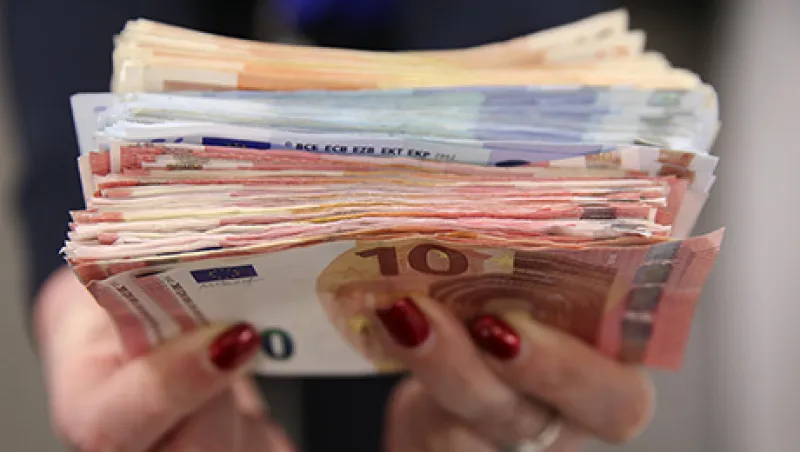As the price of oil keeps plunging, so do currencies that have owed much of their strength to the commodity once known as black gold. The 10 percent drop in the ruble on one day in mid-December was the sharpest since 1998, when Russia defaulted on its debt. By contrast, the Indian rupee, which suffered during times of high oil prices because the country imports so much petroleum, has strengthened against many other currencies — “so much against people’s expectations of 15 months ago,” says Simon Derrick, chief currency strategist at Bank of New York Mellon Corp. in London.
These stunning changes have concentrated investors’ minds on which currencies they should avoid and which ones stand to benefit, given the oil price crash. Their view depends heavily on where they see prices heading.
In mid-January Brent crude kept sinking to fresh five-year lows, well under half its 2014 peak, reaching $45 a barrel on January 13. Many investors expect oil prices to climb this year but not to the levels of 2011 through 2013, when they rarely dipped below $100.
Alex Dryden, a London-based global market strategist at J.P. Morgan Asset Management (JPMAM), is “fairly confident” that Brent crude will rebound to about $80 to $85 by the summer of 2016 as the Organization of the Petroleum Exporting Countries gradually works out a deal to cut production to put a floor on prices.
Atul Lele, CIO of $5.1 billion Deltec International Group, a Nassau, Bahamas–based private bank and wealth manager, is more optimistic still. He expects oil to rise to $90 at some point this year, supported by growth in global industrial production.
Even if these forecasts come true, the consequences aren’t as bullish for petrocurrencies as they might seem. “The reason why we’re not becoming more invested in oil currencies is because the impact of changes in oil prices on national finances is not linear,” Lele says.
Many nations have crafted their budgets on the assumption of oil prices well above the level they’re likely to reach, he reckons. JPMAM calculates a “breakeven” price — the one at which governments can run a balanced budget — at more than $100 for a range of countries including Russia and Venezuela.
Investors expecting a bounce back in the oil price could seek to profit by allocating to certain depressed oil-based currencies. JPMAM’s Dryden says a “strong-stomached investor” could put money in the hard-hit Nigerian naira, which has dropped 11 percent over the past three months, to 185 to the U.S. dollar. Analysts point to Nigeria’s relatively conservative oil price assumptions: The country’s 2015 budget is based on a forecast of just $65 a barrel for Brent crude this year, a downward adjustment from its October forecast of $78.
What are the currency plays for those who think oil prices will remain weak? “It’s easy to see what you’d sell,” says BNY Mellon’s Derrick, citing oil-dependent currencies such as the ruble, the Norwegian krone and the Canadian dollar. “It’s hard to see what you’d buy.”
The euro has been the go-to currency for those bearish on oil. The euro area is a big net petroleum importer and stands to benefit from lower crude prices. But fears of deflation in the euro area spiked after news came out earlier this month that consumer prices fell 0.2 percent in December from a year earlier. Many analysts and investors are betting that the European Central Bank will launch a big bond-buying program at its January 22 meeting in a bid to combat deflation pressures and stimulate the economy. Most analysts believe such quantitative easing would drive down interest rates and the euro. Indeed, anticipation of QE has depressed the euro against the dollar in recent weeks.
“The very last thing the euro zone needs at the moment is anything that puts downward pressure on prices and makes consumers not want to spend money,” Derrick says. Similarly, most analysts caution against betting on a rise in the yen, even though the Japanese economy stands to benefit from lower oil prices, because the Bank of Japan’s massive QE program has been pushing the currency lower.
Although the rupee has done well in recent months against many currencies, it has remained weak against the dollar, Derrick notes. The U.S. remains a net oil importer, notwithstanding the shale oil boom, and strong U.S. growth combined with expectations of rising U.S. interest rates is supporting the greenback.
That creates a conundrum for investors trying to translate bearish views on oil into currency strategies: What dollar assets are left that offer a decent return, given the rise in U.S. stocks to record highs and the low yields on U.S. bonds?
Abi Oladimeji, head of investment strategy at Thomas Miller Investment, a £2.8 billion ($4.2 billion) wealth manager based in London, advocates dollar bonds issued by emerging-markets countries that are net oil importers. When oil prices fall, these economies become richer because consumers’ income grows in real terms, he explains.
Some investors such as JPMAM’s Dryden suggest South Korean and Turkish bonds as possible plays, but others say the latter might be too adventurous, given Turkey’s volatile economic and political situation. Cheap oil won’t solve that problem.






